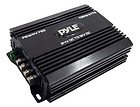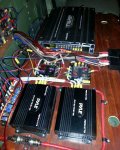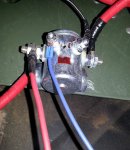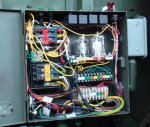Why it doesn't work, and other smoke generating topics...
Yeah, I know all the other options, was more curious why this WOULDN'T work. Frying the diodes is a good point; not sure if they make high-load diodes...
I think I see where you were going, and it's a nice try, but no cigar this time. Let's look at
why it doesn't work.
First, let's review basic diode theory. Diodes are like one-way valves in an electric circuit. If current is flowing through them in their "forward" direction, they are almost a short circuit. Very low resistance. In the other direction, the "reverse" direction, they are almost an open circuit. (There's always a little leakage. We can ignore it for now.)
Let me quote
another website here:
Diodes exhibit a low resistance to current flow in one direction and a high resistance to current flow in the other. The direction in which the current flows is referred to as the forward direction while that in which negligible current flows is known as the reverse direction. When a diode is conducting, a diode is said to be forward biased and a small voltage (ideally zero) is dropped across it. This voltage is know as the forward voltage drop.
Now let's look at the diode symbol. It sort of looks like an arrow, pointing into a wall. ---->|----
The arrow shows the forward direction of current. If there's 12v
here ---->|---- and ground is on
this side, current flows. The current hits the arrow and punches it through the wall.
However, if we reverse that: 12v ----|<---- ground Now no current flows. The current hits the wall and stops. That "arrow punching through the wall" thing helps me remember which way is which.
So let's look at your diagram (with some new labels, and a minor correction to the diode symbol):

- Diode #1. He's connected to 0v (ground) on both sides of him. No current can flow. He might as well not be there - he's doing nothing useful. Sort of like.... oh, no, I won't make any political jokes.
 "But what about the current from Diode #3?" We'll get there. Hold on.
"But what about the current from Diode #3?" We'll get there. Hold on.
- Diode #2. At first glance, it looks like this guy is forward biased (turned ON) to provide a current flow to your "12v" point. Seems reasonable, but wait, we have to consider Diode # 4. We'll get to him and then talk about his effect on #2.
- Diode #3. I have no idea what he was supposed to do, but he ain't doin' it! He's connected on one side to 12v (the - terminal of Batt 2 is connected to the + terminal of Batt 1) and the other side to ground. If he were forward biased (turned ON), you'd have pretty close to a dead short to ground.To quote one of my professors, commenting on one of my exams, "I smell smoke!"
 But he's not, he's reverse biased (turned OFF), so nothing is happening. Cut the wire and you'd have essentially the same thing. Nada.
But he's not, he's reverse biased (turned OFF), so nothing is happening. Cut the wire and you'd have essentially the same thing. Nada.
- Diode #4. Oh, aren't we clever! This is how you plan to get 24v AND 12v from both batteries! Nope. Ain't gonna work. # 4 is forward biased for 24v to flow to that "12v" point in your diagram. That's 12v more positive than the 12v you thought you had there from Diode #2. So, #2 is actually reverse biased (turned OFF), leaving you with current flow from the 24v terminal to whatever loads are connected to that "12v" point in your diagram. It ain't 12v at that point, it turns out to be 24v. Oops. So, depending on the current rating of that diode, the amount of load you have on that part of the circuit, and the voltage tolerance of the devices connected to it, you just might get some smoke out of that machine.

But what you will NOT get is 12v AND 24v drawn from BOTH batteries.
Clear as mud?








